Go_for_it七年级英语下册句型和短语、重难点总结
人教版七年级下册英语期末复习:Unit 7-Unit 12 各单元语法知识点复习提纲(全面!)
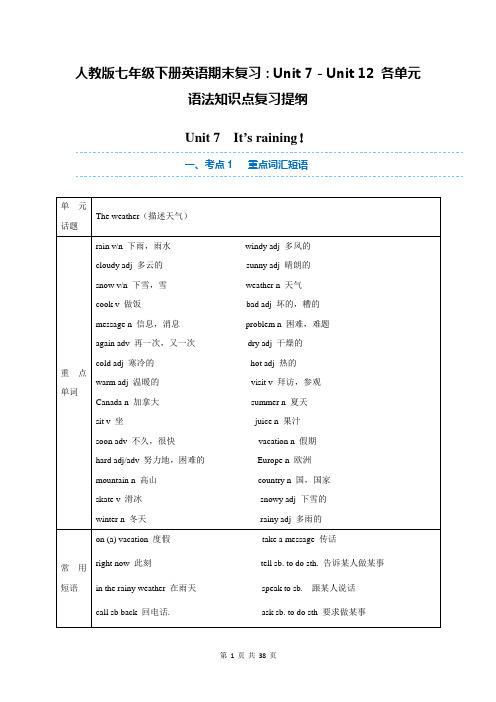
人教版七年级下册英语期末复习:Unit 7-Unit 12 各单元语法知识点复习提纲Unit 7 It’s raining!一、考点1 重点词汇短语1 messagemessage为可数名词,意为“消息,信息”,take a message for sb.“为某人捎个口信”。
拓展:give sb. a message 捎信给某人,leave a message 留口信,get the message 明白对方的意思。
Can I take a message for him?当某人发现要找的人不在或接电话的人发现打电话者要找的人不在时,常用此语2 could 情态动词意为“能,可以“,表示请求许可,在语气上比can委婉客气,但这种句式的肯定回答用can。
Could you just tell him to call me back?3 call及物动词,意为“打电话给”。
call sb. (up) “打电话给某人”,call sb. at +电话号码,意为“拨打……找某人”。
拓展:call 是一个多义词,call sb 可表示“叫醒某人,呼唤某人”;give sb. a call 给某人打电话。
4 back副词“回来,回原处,向后”;call sb. back给某人回个电话。
【即学即练】I’ll _____you _____.我将给你回电话。
5 visit此处用作及物动词,意为“拜访,探望”,后接表示人的名词或代词。
visit还可意为“参观,游览”,后接表示地点的名词。
拓展:visit还可用作可数名词,意为“访问,参观,拜访。
be on a visit to ... “正在访问/参观……”。
visitor参观者,游览者,游客。
I’m having a great time visiting my aunt in Canada._____ my grandparents every year at Christmas.我每年圣诞节都去探望我的祖父母。
人教版英语七年级下册 Unit 1 ---unit3重难点 归纳
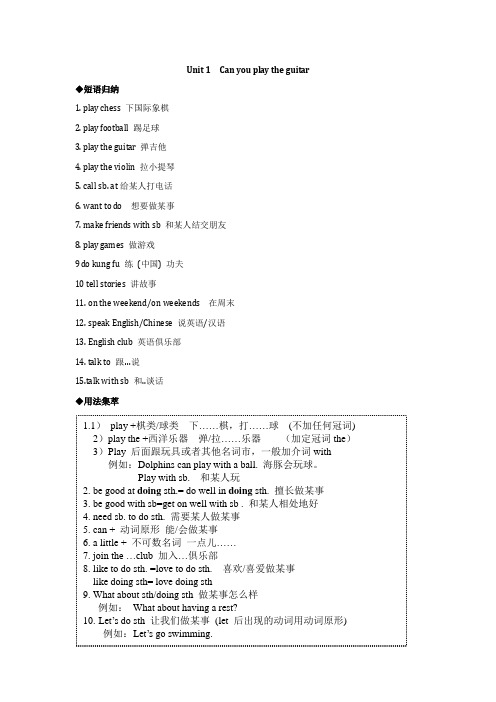
Unit 1 Can you play the guitar◆短语归纳1. play chess 下国际象棋2. play football 踢足球3. play the guitar 弹吉他4. play the violin 拉小提琴5. call sb. at给某人打电话6. want to do 想要做某事7. make friends with sb 和某人结交朋友8. play games 做游戏9 d o kung fu 练(中国) 功夫10 tell stories 讲故事11. on the weekend/on weekends 在周末12. speak English/Chinese 说英语/汉语13. English club 英语俱乐部14. talk to 跟…说15.talk with sb 和..谈话◆用法集萃1.1)play +棋类/球类下……棋,打……球(不加任何冠词)2)play the +西洋乐器弹/拉……乐器(加定冠词the)3)Play 后面跟玩具或者其他名词市,一般加介词with 例如:Dolphins can play with a ball. 海豚会玩球。
Play with sb. 和某人玩2. be good at doing sth.= do well in doing sth. 擅长做某事3. be good with sb=get on well with sb . 和某人相处地好4. need sb. to do sth. 需要某人做某事5. can + 动词原形能/会做某事6. a little + 不可数名词一点儿……7. join the …club 加入…俱乐部8. like to do sth. =love to do sth. 喜欢/喜爱做某事like doing sth= love doing sth9. What about sth/doing sth 做某事怎么样例如:What about having a rest?10.Let’s do sth 让我们做某事(let 后出现的动词用动词原形)例如:Let’s go swimming.◆重难点注释一.Can 的用法1. 表示能力She can sing that song in English. 她能用英文唱那首歌。
七年级英语Go for it!下册句型和短语、重难点总结
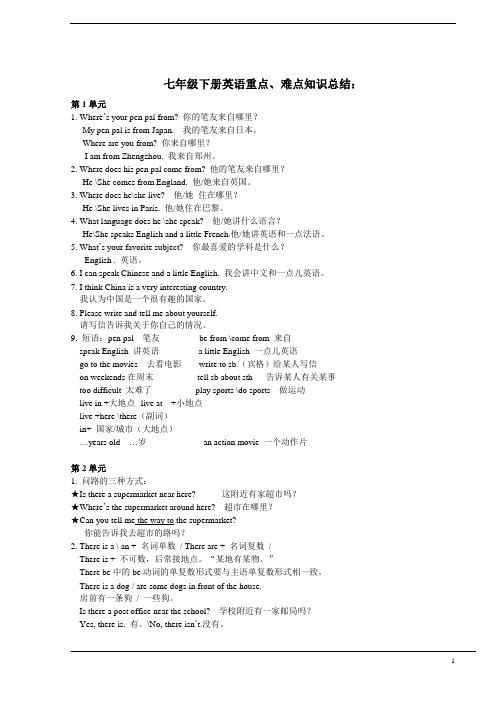
七年级下册英语重点、难点知识总结:第1单元1. Where’s your pen pal from? 你的笔友来自哪里?-My pen pal is from Japan. 我的笔友来自日本。
-Where are you from? 你来自哪里?- I am from Zhengzhou. 我来自郑州。
2. Where does his pen pal come from? 他的笔友来自哪里?-He \She comes from England. 他/她来自英国。
3. Where does he\she live? 他/她住在哪里?-He \She lives in Paris. 他/她住在巴黎。
4. What language does he \she speak? 他/她讲什么语言?-He\She speaks English and a little French.他/她讲英语和一点法语。
5. What’s your favorite subject? 你最喜爱的学科是什么?- English . 英语。
6. I can speak Chinese and a little English. 我会讲中文和一点儿英语。
7. I think China is a very interesting country.我认为中国是一个很有趣的国家。
8. Please write and tell me about yourself.请写信告诉我关于你自己的情况。
9. 短语:pen pal 笔友be from \come from 来自speak English 讲英语 a little English 一点儿英语go to the movies 去看电影write to sb.(宾格)给某人写信on weekends在周末tell sb about sth 告诉某人有关某事too difficult 太难了play sports \do sports 做运动live in +大地点live at +小地点live +here \there(副词)in+ 国家/城市(大地点)…years old …岁an action movie 一个动作片第2单元1. 问路的三种方式:★Is there a supermarket near here? 这附近有家超市吗?★Where’s the supermarket around here? 超市在哪里?★Can you tell me the way to the supermarket?你能告诉我去超市的路吗?2. There is a \ an + 名词单数/ There are + 名词复数/There is + 不可数,后常接地点。
七年级下册英语人教版全册每单元学习目标和重难点
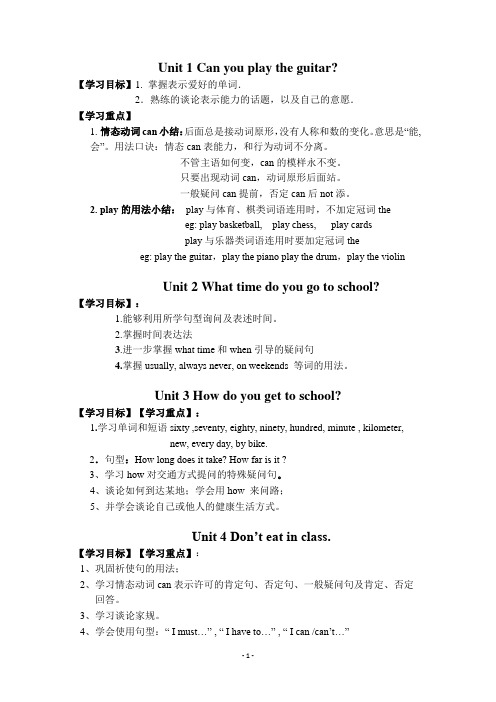
Unit 1Can you play the guitar?【学习目标】1. 掌握表示爱好的单词.2.熟练的谈论表示能力的话题,以及自己的意愿.【学习重点】1.情态动词can小结:后面总是接动词原形,没有人称和数的变化。
意思是“能,会”。
用法口诀:情态can表能力,和行为动词不分离。
不管主语如何变,can的模样永不变。
只要出现动词can,动词原形后面站。
一般疑问can提前,否定can后not添。
2. play的用法小结:play与体育、棋类词语连用时,不加定冠词theeg: play basketball, play chess, play cardsplay与乐器类词语连用时要加定冠词theeg: play the guitar,play the piano play the drum,play the violinUnit 2 What time do you go to school?【学习目标】:1.能够利用所学句型询问及表述时间。
2.掌握时间表达法3.进一步掌握what time和when引导的疑问句4.掌握usually, always never, on weekends 等词的用法。
Unit 3 How do you get to school?【学习目标】【学习重点】:1.学习单词和短语sixty ,seventy, eighty, ninety, hundred,minute , kilometer, new, every day, by bike.2.句型:How long does it take? How far is it ?3、学习how对交通方式提问的特殊疑问句。
4、谈论如何到达某地;学会用how 来问路;5、并学会谈论自己或他人的健康生活方式。
Unit 4 Don’t eat in class.【学习目标】【学习重点】:1、巩固祈使句的用法;2、学习情态动词can表示许可的肯定句、否定句、一般疑问句及肯定、否定回答。
人教版go for it七年级英语下教学设计
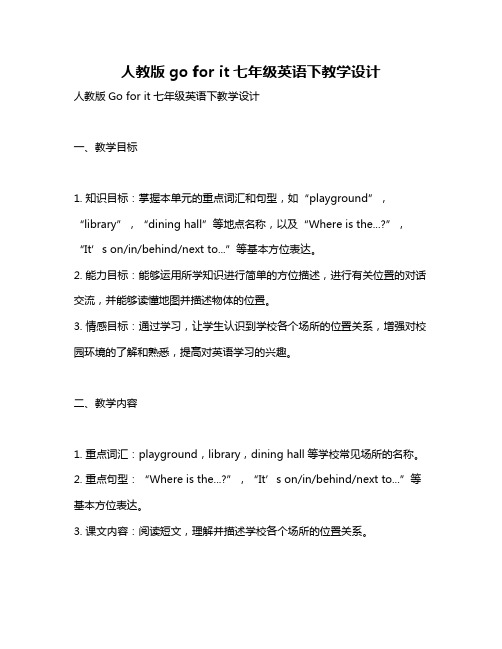
人教版go for it七年级英语下教学设计人教版Go for it七年级英语下教学设计一、教学目标1. 知识目标:掌握本单元的重点词汇和句型,如“playground”,“library”,“dining hall”等地点名称,以及“Where is the...?”,“It’s on/in/behind/next to...”等基本方位表达。
2. 能力目标:能够运用所学知识进行简单的方位描述,进行有关位置的对话交流,并能够读懂地图并描述物体的位置。
3. 情感目标:通过学习,让学生认识到学校各个场所的位置关系,增强对校园环境的了解和熟悉,提高对英语学习的兴趣。
二、教学内容1. 重点词汇:playground,library,dining hall等学校常见场所的名称。
2. 重点句型:“Where is the...?”,“It’s on/in/behind/next to...”等基本方位表达。
3. 课文内容:阅读短文,理解并描述学校各个场所的位置关系。
三、教学难点与重点1. 难点:方位介词的准确使用,如“on”,“in”,“behind”,“next to”等。
2. 重点:熟练运用方位词描述物体的位置,进行简单的方位对话。
四、教具和多媒体资源1. 投影仪及PPT课件2. 教学卡片3. 学校平面图模型五、教学方法1. 激活学生的前知:通过提问学生校园内的场所名称,激活学生的前知。
2. 教学策略:采用讲解、示范、小组讨论、情境模拟等多种教学方法,帮助学生理解并掌握知识点。
3. 学生活动:组织学生进行角色扮演、地图标注等活动,提高学生的学习参与度和实践能力。
六、教学过程1. 导入(5分钟)通过提问学生校园内的场所名称,激活学生的前知。
然后展示学校平面图模型,让学生对学校各个场所的位置关系有初步了解。
2. 讲授新课(15分钟)通过PPT展示本单元的重点词汇和句型,进行讲解和示范。
然后介绍课文内容,引导学生理解并描述学校各个场所的位置关系。
人教版新目标go for it 七年级下册U5 单词拼写,课文填空和知识点总结梳理
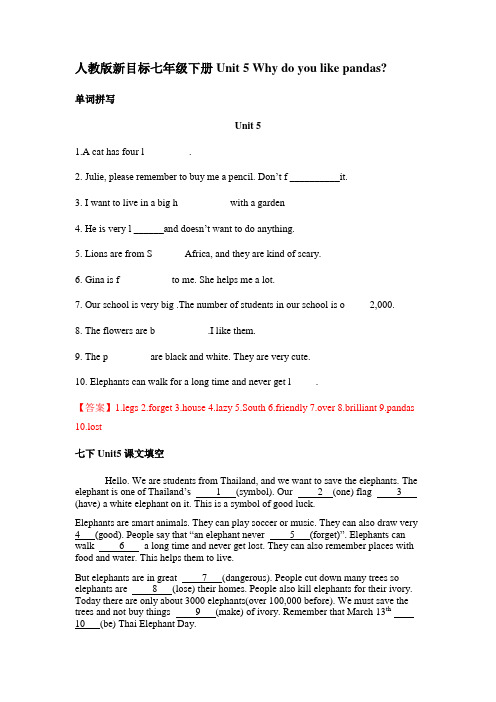
人教版新目标七年级下册Unit 5 Why do you like pandas?单词拼写Unit 51.A cat has four l_________.2. Julie, please remember to buy me a pencil. Don’t f __________it.3. I want to live in a big h__________ with a garden4. He is very l ______and doesn’t want to do anything.5. Lions are from S ______Africa, and they are kind of scary.6. Gina is f __________to me. She helps me a lot.7. Our school is very big .The number of students in our school is o_____2,000.8. The flowers are b __________.I like them.9. The p ________are black and white. They are very cute.10. Elephants can walk for a long time and never get l_____.【答案】1.legs 2.forget 3.house zy 5.South 6.friendly 7.over 8.brilliant 9.pandas 10.lost七下Unit5课文填空Hello. We are students from Thailand, and we want to save the elephants. The elephant is one of Thailand’s 1 (symbol). Our 2 (one) flag 3 (have) a white elephant on it. This is a symbol of good luck.Elephants are smart animals. They can play soccer or music. They can also draw very 4 (good). People say that “an elephant never 5 (forget)”. Elephants can walk 6 a long time and never get lost. They can also remember places with food and water. This helps them to live.But elephants are in great 7 (dangerous). People cut down many trees so elephants are 8 (lose) their homes. People also kill elephants for their ivory. Today there are only about 3000 elephants(over 100,000 before). We must save the trees and not buy things 9 (make) of ivory. Remember that March 13th10 (be) Thai Elephant Day.Keys: symbols, first, had, well, forgets, for, danger, losing, made, is.Section A重点单词听,跟读下列单词1.panda n.熊猫2.zoo n.动物园3. tiger n.老虎4. elephant n.大象5. koala n.树袋熊;考拉6, lion n,狮子7. giraffe n.长颈鹿8. animal n.动物9. cute adj.可爱的;机灵的10. lazy adj.懒散的;懒惰的11. art adj.聪明的12. beautiful adj.美丽的;美好的13. scary adj.吓人的;恐怖的14. kind n.种类15. Australia n.澳大利亚16. south adj.南方的n.南;南方17. Africa n.非洲18. pet n.宠物19.leg n.腿20,cat n.猫21, sleep v.&n.睡觉听,并跟读下列单词变形1. panda- pandas(复数)2. giraffe- giraffes(复数)3. interest--interesting/ interested(形容词)4. kind of- a little(同义短语)5. sleep- sleeps(第三人称单数)6. be from- come from(同义短语)7. beauty- beautiful(形容词)重点短语听,并跟读下列短语1. all day整天2. black and white黑白的3.a lot非常;很4. let sb. do sth. 让某人做某事5. want to do sth.想做某事6. kind of稍微;有点儿7. South Africa南非8. really scary确实吓人9. walk on two legs用两条腿走路10. be from来自重点句型听,并跟读下列句子1.“咱们先看熊猫吧,我最喜欢熊猫了。
人教版新目标go for it 七年级下册Unit3 单词拼写,课文填空和知识点总结梳理 含答案
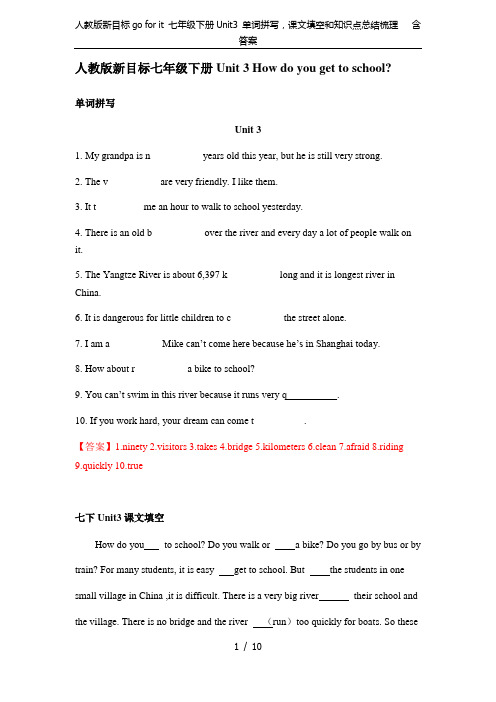
人教版新目标七年级下册Unit 3 How do you get to school?单词拼写Unit 31.My grandpa is n__________ years old this year, but he is still very strong.2. The v__________ are very friendly. I like them.3. It t_________ me an hour to walk to school yesterday.4. There is an old b__________ over the river and every day a lot of people walk on it.5. The Yangtze River is about 6,397 k__________ long and it is longest river in China.6. It is dangerous for little children to c__________ the street alone.7. I am a__________ Mi ke can’t come here because he’s in Shanghai today.8. How about r__________ a bike to school?9. You can’t swim in this river because it runs very q__________.10. If you work hard, your dream can come t__________.【答案】1.ninety 2.visitors 3.takes 4.bridge 5.kilometers 6.clean 7.afraid 8.riding 9.quickly 10.true七下Unit3课文填空How do you to school? Do you walk or a bike? Do you go by bus or by train? For many students, it is easy get to school. But the students in one small village in China ,it is difficult. There is a very big river their school and the village. There is no bridge and the river (run)too quickly for boats. So thesestudents go on a ropeway to cross the river to school.One 11-year-old boy, Liangliang, (cross)the river every school day. he is notafraid.“I love to play my classmates. And I love my teacher. He’s like a father tome.”Many of the students and villagers never leave the village. It is their dream to have a bridge. Can their dream come ?Keys: get; ride; to; for; between; runs; crosses; But; with; trueSection A重点单词听,并跟读下列单词1. train n.火车2.bus n.公共汽车3. subway n.地铁4. ride v.骑n.旅程5. bike n.自行车6. sixty num.六十7. seventy num.七十8. eighty num.八十9. ninety num.九十10. hundred num. 一百11. minute n.分钟12. far adv.&adj. 远;远的13, kilometer= kilometre n.千米;公里14. new adj.新的;刚出现的15. every adj.每一;每个16. by prep.(表示方式)乘(交通工具) 17, drive v.开车18. car n.小汽车;轿车19. live v.居住;生活听,并跟读下列单词变形1.bus- buses(复数)2. sixty--sixties(复数)3. far-near(反义词)4.live- -living(现在分词)5. drive- driving(现在分词)- driver(名词)重点短语听,并跟读下列短语1.take the train乘火车2. take the bus乘公共汽车3. take the subway乘地铁4. ride a bike/ by bike骑自行车5. every day每天6. get to school到达学校7. one hundred and five一百零五8. how far多远9. how long多长时间10. ride a bike to school骑自行车去上学11. have a good day度过愉快的一天重点句型听,并跟读下列句子1.“你如何去学校?”“我骑自行车去学校。
七年级英语预备篇Unit2
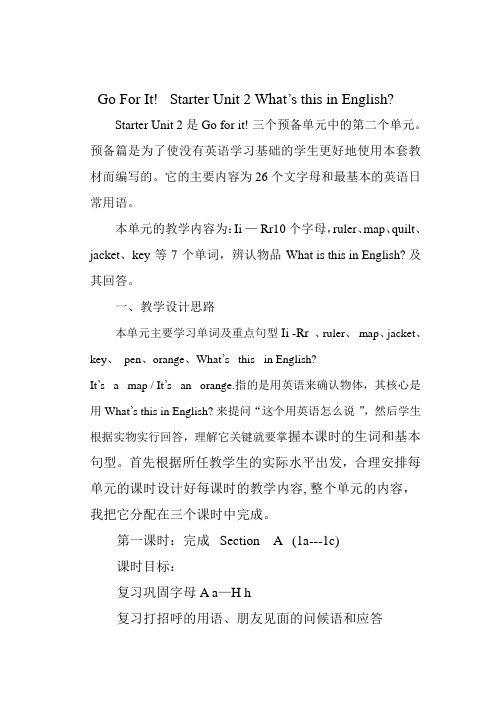
Go For It! Starter Unit 2 What’s this in English?Starter Unit 2是Go for it! 三个预备单元中的第二个单元。
预备篇是为了使没有英语学习基础的学生更好地使用本套教材而编写的。
它的主要内容为26个文字母和最基本的英语日常用语。
本单元的教学内容为:Ii — Rr10个字母,ruler、map、quilt、jacket、key等7个单词,辨认物品What is this in English? 及其回答。
一、教学设计思路本单元主要学习单词及重点句型Ii -Rr、ruler、map、jacket、key、pen、orange、What’s this in English?It’s a map / It’s an orange.指的是用英语来确认物体,其核心是用What’s this in English? 来提问“这个用英语怎么说”,然后学生根据实物实行回答,理解它关键就要掌握本课时的生词和基本句型。
首先根据所任教学生的实际水平出发,合理安排每单元的课时设计好每课时的教学内容, 整个单元的内容,我把它分配在三个课时中完成。
第一课时:完成Section A (1a---1c)课时目标:复习巩固字母A a—H h复习打招呼的用语、朋友见面的问候语和应答学习字母Ii – Rr,了解一些英语缩略词的意思学习元音字母a、e、 i、o在开音节和闭音节中的音规则第二课时:完成Section A——2a,2b,2c,2d,3;Section B——1a,1b,2a,2b课时目标:巩固字母:Ii – Rr 及7个单词。
学习: key、pen map、 ruler、orange、quilt、 jacket 等7个词汇。
学习辨认物体:What’s this in English? It’s ……学习a / an的用法:a key, an orange学习拼写单词和相关句型:Spell it, please. K-E-Y,key.第三课时:完成Section A—4a,4b,4c,5;Section B—3a,3b,4;Self Check 1,2,3,4。
初中英语_Unit 7 SectionB 2b教学设计学情分析教材分析课后反思

七年级下册Unit 7 Section B 2b-3c 教学设计一、教学目标1、知识目标:谈论天气,让学生掌握与天气话题相关的词汇,熟练运用现在进行时描述自己及他人正在进行的活动,通过读写活动进一步巩固学生对目标语言的认识和理解,让学生能够围绕天气和活动话题进行口头和笔头的语言输出。
2、能力目标:通过阅读,引导学生在阅读过程中能够寻找关键信息,并能借助关键词对文章进行概括复述,从而提高学生总结归纳语篇信息的能力。
3、情感目标:增加文化积累,开阔学生视野,有效调动学生学习英语的积极性。
通过阅读明信片,写明信片,互赠明信片,加强学生间的情感交流,唤起学生对生活的热爱和向往。
二、教学重难点本课时重点就是描述天气的情况和现在进行时的用法,明信片的文体特点等;难点现在进行时的另一种用法,即表示一段时间内正在进行的动作和状态。
三、教学方法教师采用任务型教学方法让学生主动参与和小组合作探究,迅速有效地开展各项活动。
四、教学工具多媒体教学设备五、教学过程Step 1 Lead in.Task 1Listen to a weather song. Ss and the teacher sing the song together.Task 2 Talk about the pictures in 2a.A: How’s the weather? B: It’s …….A: What’s she/he doing? B: She/He is ……. Step 2 Reading.Task 1 Listen and match the postcard with the correct pictures.Task 2 Careful reading.Read postcard 1 and answer the questions.Read postcard 2 and finish the tasks in groups.Task 3 Read the postcards with the tape.Task 4Read the information and fill in the blanks in 2c. Step 3 Writing.Task 1Talk about the picture in 3a and fill in the blanks.Task 2 Pair work.Imagine you are on a May Day vacation, talk with your partner about your vacation.Task 3Write a postcard to your friend. Tell your friendyour vacation and what you are doing.Step 4 SummaryReview the words and phrases.Understand the forms of the postcard.Step 5 Model aimMake friends as many as you can and get on well with them. Step 6 HomeworkRemember the words by heart.Write a postcard about your summer vacation and send it to me.七年级下册Unit 7 Section B 2b-3c学情分析处在七年级年龄段的学生想事,做事都有了一定的判断能力,但有一定的情绪化,在上课时要做好引导工作,首先,解决思想问题,其次,注重培养学生的学习习惯,因为此年龄段的学生自控力很差,而且往往对一些电视,网络游戏非常感兴趣,这就要求老师以自己的人格魅力,来影响学生,为学生树好榜样,提高自身的威信,让学生感到老师所说的,所做的是很有意义的,引导他们按照老师设计好的方案进行。
七年级英语下册(人教新目标Goforit!)Unit2第3课时(SectionB1a1e)教学设计

五、作业布置
为了巩固本节课所学知识,提高学生的综合语言运用能力,特布置以下作业:
1.口语作业:学生需准备一段关于自己或他人成功经历的口语表达,要求运用本节课所学的一般现在时和一般过去时,以及核心词汇和短语。在下一节课上进行分享,以提高学生的口语交流能力。
4.提高学生的听力理解能力,能够听懂并获取课文中的关键信息。
5.提高学生的阅读理解能力,通过阅读课文,了解成功人士的经历和品质。
(二)过程与方法
1.通过小组合作、讨论、分享等形式,培养学生合作学习、自主探究的能力。
2.利用多媒体教学手段,如图片、视频等,激发学生的学习兴趣,提高课堂教学效果。
3.通过听力训练、口语表达、阅读理解等教学活动,帮助学生巩固所学知识,提高综合语言运用能力。
四、教学内容与过程
(一)导入新课
1.教师通过展示一幅描绘成功人士的图片,引导学生观察并思考:“What does this person do? How do you think she achieved success?”,从而自然引入本节课的主题。
2.教师邀请学生分享他们所了解的成功人士及其成就,激发学生对成功、努力、梦想等话题的兴趣。
4.鼓励学生积极参与课堂活动,培养他们的自信心和表达能力。
5.教师引导学生进行总结和反思,帮助他们发现自身的学习方法和策略。
(三)情感态度与价值观
1.培养学生树立正确的价值观,认识到成功需要付出努力,勇往直前,不怕失败。
2.培养学生积极向上的心态,敢于追求梦想,为实现目标而努力拼搏。
3.培养学生关爱他人,学会倾听他人的经历和故事,尊重他人的选择和努力。
2.写作作业:请学生结合本节课所学的成功、努力、梦想等主题,写一篇不少于80词的短文。要求运用一般现在时和一般过去时进行描述,内容可以包括自己的梦想、为梦想付出的努力以及未来的计划。
七年级英语下册(人教新目标Goforit!)Unit12第3课时(SectionB1a1e)教学设计

(五)总结归纳
1.教师引导学生回顾本节课所学内容,总结一般现在时态的用法和比赛、活动相关的词汇和短语。
2.学生分享在本节课中的收获和感悟,教师给予肯定和鼓励。
3.强调团队合作的重要性,培养学生积极向上的竞争意识和合作精神。
4.布置课后作业,要求学生运用本节课所学知识,描述一次自己参加的比赛或活动经历。
3.阅读拓展:阅读一篇关于比赛或活动的英文文章,如体育赛事、音乐比赛等。要求理解文章内容,并找出文章中使用的一般现在时态的句子。
4.词汇积累:整理本课时学到的比赛、活动相关词汇和短语,制作成词汇卡片,以便随时复习。
5.家庭作业:完成课本练习册中与本课时相关的练习题,巩固所学知识。
6.拓展任务:鼓励学生参加学校或社区举办的英语比赛、活动,如英语演讲、歌曲演唱等,将所学知识应用于实际情境。
2.通过示例句型,让学生理解并掌握一般现在时态的用法,如:“He often practices basketball after school.”
3.引导学生运用一般现在时态描述比赛、活动中的动作和状态,巩固新学的词汇和语法知识。
4.播放听力材料,让学生在听的过程中,关注一般现在时态的运用和比赛、活动相关词汇的发音。
七年级英语下册(人教新目标Goforit!)Unit12第3课时(SectionB1a1e)教学设计
一、教学目标
(一)知识与技能
在本章节的学习中,学生将能够:
1.掌握本课时出现的重点词汇和短语,如: competition, winner, prize, practice, team, lose等,并能在实际情境中正确运用。
人教版新目标go for it 七年级下册Unit1 单词拼写,课文填空和知识点总结梳理

人教版新目标七年级下册Unit 1 Can you play the guitar?单词拼写1. Grandma usually t__________ interesting stories to the kids.2. Leo is an English boy, but he can s__________ good Chinese.3. Alex is good at d__________ pictures.4. My favorite subject is music, and I can play the p__________.5. Jack likes w__________ stories. He w__________ a story yesterday.6. Gina wants to j__________the music club.7. Mary likes singing and dancing. She wants to be a m__________ in the future.8. Welcome to our school. Let me s__________ you around.9. There are two p__________ in the classroom. One is a teacher, the other is Mary’s mother.10. –Can you help us t__________ the music? –Sorry, I’m too busy.【答案】1.tells 2.speak 3.drawing 4.piano 5.writing wrote 6.join 7.musician 8.show 9.people 10.turn on七下unit1课文填空Hello, I’m peter. I like to play basketball. I can speak English and I can 1______ (too) play soccer.Hi, I’m Ma Huan. I can play ping-pong and chess. I like to talk and play games 2_____people.Are you busy after school? No? can you speak English?Yes? Then we need you 3_______ (help) 4______sports for English-speaking students. It is 5_______ (relax) and easy! Please come to the students’ sports center. Call Mr. Brown at 293-7742.We need help at the old 6_____ (people) home. Are you free in July?Are you 7______ (well) with old people? Can you 8_____ (talk) to them and play games withthem? They can tell you stories, and you can make 9_____ (friend). It is interesting and fun! Please call us 10______689-7729 today!Keys: also; with; to help; with; relaxing; people’s; good; talk; friends; atSection A重点单词听,并跟读下列单词1. guitar n.吉他2. sing v.唱歌3. swim v.&n.游泳4. dance v.跳舞n.舞蹈5. draw v. 画画6. chess n. 国际象棋7. speak v.说(某种语言);说话8. join v. 参加;加入9. club n.俱乐部;社团10. tell v.讲述;告诉11. story n.故事;小说12.write v. 写作;写字13. show n. 演出;节目v. 给……看;展示14. or conj.或者;也不(用于否定句)15.talk v.&n.说话;交谈16. kung fu n.(中国)功夫听,并跟读下列单词变形1.sing- singer(名词)2.swim- swimmer(名词)3. dance- dancer(名词)4.draw- drawing(名词)5. speak- speaker(名词)6.tell- teller(名词)7. story- stories(复数)8. write-writer(名词)重点短语听,并跟读下列短语1. play chess下国际象棋2. speak English说英语3. play the guitar弹吉他4. join the music club加入音乐俱乐部5. swimming club游泳俱乐部6. art club美术俱乐部7. sports club运动俱乐部8. the story telling club讲故事俱乐部9. be good at…擅长于…10. like to draw喜欢画画11. talk to sb.跟……说话12. in the music room在音乐室里13. school show学校演出14. show us向我们展示一下重点句型听,并跟读下列句子1.“你会游泳吗?”“不,我不会。
人教版七年级下册英语重点短语与知识点(调整版)

Unit 1 Can you play the guitar? 知识点一.重点短语1. play the guitar 弹吉他2. play the piano 弹钢琴3. play the drums 敲鼓4. play chess 下象棋5. speak English 说英语6. join the art club 加入艺术俱乐部7. join the basketball club 加入篮球俱乐部8. join the swimming club 加入游泳俱乐部Join the NBA 加入NBA9. play the guitar well 弹吉他弹得好10. be good with sb. 和某人相处的好11. be good for···对······有益处12. be good at···擅长······13. help sb with sth 帮助某人干某事help with sb/sth 帮助某人/某事14.a little 一点(后接不可数名词)15. show sth to sb = show sb sth 把某物给某人看16. old people’s home 养老院17. make friends 交朋友18. the Students’ Sports Center 学生运动中心19. make friends with sb. 与某人交朋友20. need sb to do sth 需要某人做……二.重点句型1. — Can you play the guitar? 你会弹吉他吗?—Yes, I can. 是的,我会。
—No, I can’t. 不,我不会。
2. —What club do you want to join? 你想参加什么俱乐部?—I want to join the art club. 我想加入艺术俱乐部。
新目标(Go for it)版七年级英语下册默写(单词+词性转换+短语,无答案)

七年级(下)Units 1—4一、重点单词A.根据汉语意思写出正确的单词。
1.____________(n.)吉他2.____________(v.)唱歌3.____________(v.& n.)游泳4.____________(v.)跳舞(n.)舞蹈5.____________(v.)画6.____________(v.)参加;加入7.____________(n.)俱乐部;社团8.____________(n.)故事;小说9.____________(n.)演出;节目(v.)给……看;展示10.____________(v.& n.)说话;交谈11.____________(n.)鼓12.____________(n.)钢琴13.____________(n.)小提琴14.____________(n.)人;人们15.____________(n.)周末16.____________(n.)音乐家17.____________(v.)穿衣服(n.)连衣裙18.____________(v.)刷;刷净(n.)刷子19.____________(v.)淋浴(n.)淋浴器(间)20.____________(adv.)通常地;一般地21.____________(num.)四十22.____________(num.)五十23.____________(n.)工作;职业24.____________(n.& v.)工作25.____________(adj.)奇怪的;滑稽好笑的26.____________(prep.)晚于;过(时间)(adj.)过去的27.____________(n.)一刻钟;四分之一28.____________(v.)跑;奔29.____________(v.)打扫;弄干净(adj.)干净的30.____________(n.& v.)行走;步行31.____________(n.)地铁32.____________(v.)骑(n.)旅程33.____________(num.)九十34.____________(n.)分钟35.____________(adv.& adj.)远;远的36.____________(v.)居住;生活37.____________(v.)横过;越过38.____________(n.)河;江39.____________(n.)村庄;村镇40.____________(n.)桥41.____________(n.)小船42.____________(n.)梦想;睡梦(v.)做梦43.____________(adj.)真的;符合事实的44.____________(n.)规则;规章45.____________(v.)到达46.____________(v.& n.)打架;战斗47.____________(v.)穿;戴48.____________(v.)带来;取来49.____________(adj.)脏的50.____________(n.)厨房51.____________(v.)放松;休息52.____________(v.)读;阅读53.____________(v.)记住;记起54.____________(v.)遵循;跟随B.根据首字母和汉语提示写出正确的单词。
初一英语下册重难点句型汇总
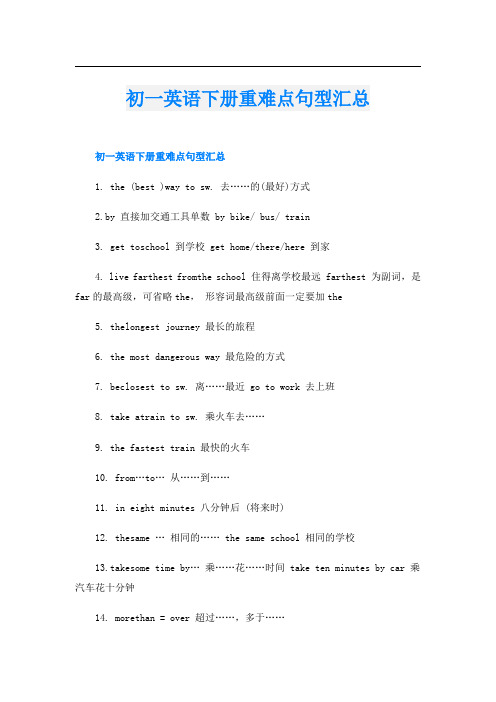
初一英语下册重难点句型汇总初一英语下册重难点句型汇总1. the (best )way to sw. 去……的(最好)方式2.by 直接加交通工具单数 by bike/ bus/ train3. get toschool 到学校 get home/there/here 到家4. live farthest fromthe school 住得离学校最远 farthest 为副词,是far的最高级,可省略the,形容词最高级前面一定要加the5. thelongest journey 最长的旅程6. the most dangerous way 最危险的方式7. beclosest to sw. 离……最近 go to work 去上班8. take atrain to sw. 乘火车去……9. the fastest train 最快的火车10. from…to…从……到……11. in eight minutes 八分钟后 (将来时)12. thesame …相同的…… the same school 相同的学校13.takesome time by…乘……花……时间 take ten minutes by car 乘汽车花十分钟14. morethan = over 超过……,多于……15. oneof the busiest international airlines 最繁忙的航线之一16. adistance of …kilometres ……公里的距离17. in nine and a half hours 在九个半小时后18. buy aticket at the bus stop 在汽车站买票 19. millions of Americans 上百万美国人20. Ataxi from Shanghaito the airport is cheaper than the train for two people.对两个人来说从上海到机场乘出租车比乘火车便宜。
GO-for-it七年级下册英语每单元知识点总结加练习
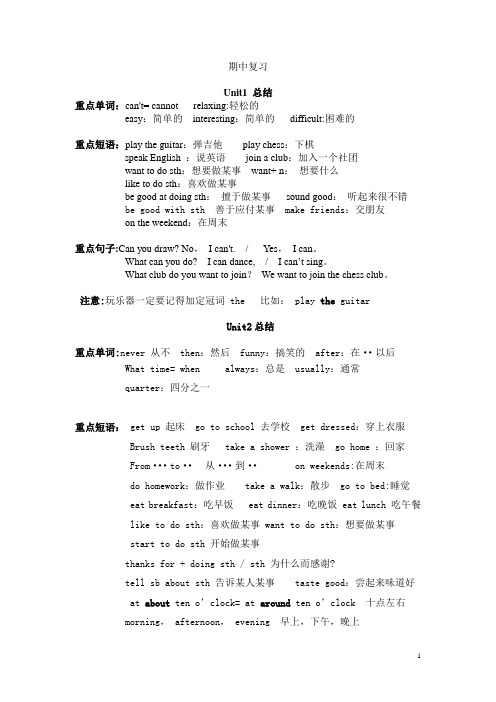
期中复习Unit1 总结重点单词:can't= cannot relaxing:轻松的easy:简单的interesting:简单的difficult:困难的重点短语:play the guitar:弹吉他play chess:下棋speak English :说英语join a club:加入一个社团want to do sth:想要做某事want+ n:想要什么like to do sth:喜欢做某事be good at doing sth:擅于做某事sound good:听起来很不错be good with sth 善于应付某事 make friends:交朋友on the weekend:在周末重点句子:Can you draw? No,I can't. / Yes,I can。
What can you do? I can dance, / I can’t sing。
What club do you want to join?We want to join the chess club。
注意:玩乐器一定要记得加定冠词 the 比如: play the guitarUnit2总结重点单词:never 从不 then:然后 funny:搞笑的 after:在··以后What time= when always:总是 usually:通常quarter:四分之一重点短语: get up 起床 go to school 去学校 get dressed:穿上衣服Brush teeth 刷牙 take a shower :洗澡 go home :回家From···to··从···到·· on weekends:在周末do homework:做作业 take a walk:散步 go to bed:睡觉 eat breakfast:吃早饭 eat dinner:吃晚饭 eat lunch 吃午餐 like to do sth:喜欢做某事 want to do sth:想要做某事 start to do sth 开始做某事thanks for + doing sth / sth 为什么而感谢?tell sb about sth 告诉某人某事 taste good:尝起来味道好 at about ten o’clock= at around ten o’clock 十点左右morning, afternoon, evening 早上,下午,晚上重点句子:What time do you usually get up? I usually get up at six thirty。
七年级英语Go for it!上册句型和短语总结 试题
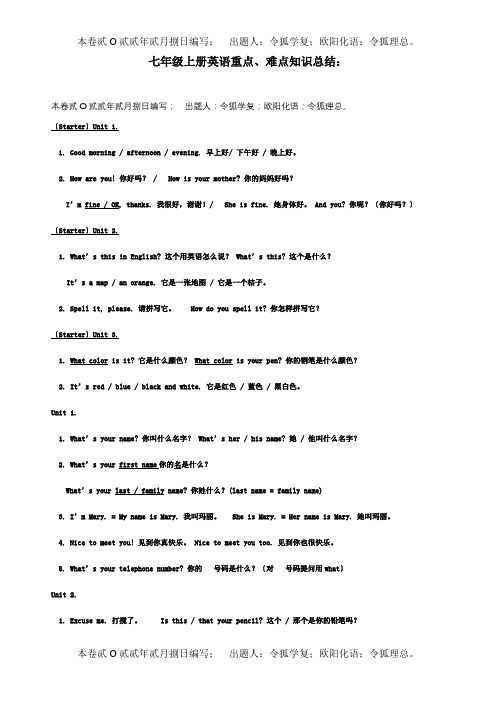
七年级上册英语重点、难点知识总结:本卷贰O贰贰年贰月捌日编写;出题人:令狐学复;欧阳化语;令狐理总。
〔Starter〕Unit 1.1. Good morning / afternoon / evening. 早上好/ 下午好 / 晚上好。
2. How are you! 你好吗? / How is your mother? 你的妈妈好吗?I’m fine / OK, thanks. 我很好,谢谢!/ She is fine. 她身体好。
And you? 你呢?〔你好吗?〕〔Starter〕Unit 2.1. What’s this in English? 这个用英语怎么说? What’s this? 这个是什么?It’s a map / an orange. 它是一张地图 / 它是一个桔子。
2. Spell it, please. 请拼写它。
How do you spell it? 你怎样拼写它?〔Starter〕Unit 3.1. What color is it? 它是什么颜色? What color is your pen? 你的钢笔是什么颜色?2. It’s red / blue / black and white. 它是红色 / 蓝色 / 黑白色。
Unit 1.1. What’s your name? 你叫什么名字? What’s her / his name? 她 / 他叫什么名字?2. What’s your first name你的名是什么?What’s your last / family name? 你姓什么?(last name = family name)3. I’m Mary. = My name is Mary. 我叫玛丽。
She is Mary. = Her name is Mary. 她叫玛丽。
4. Nice to meet you! 见到你真快乐。
Nice to meet you too. 见到你也很快乐。
- 1、下载文档前请自行甄别文档内容的完整性,平台不提供额外的编辑、内容补充、找答案等附加服务。
- 2、"仅部分预览"的文档,不可在线预览部分如存在完整性等问题,可反馈申请退款(可完整预览的文档不适用该条件!)。
- 3、如文档侵犯您的权益,请联系客服反馈,我们会尽快为您处理(人工客服工作时间:9:00-18:30)。
七年级下册英语重点、难点知识总结:第1单元1. Where’s your pen pal from? 你的笔友来自哪里?-My pen pal is from Japan. 我的笔友来自日本。
-Where are you from? 你来自哪里?- I am from Zhengzhou. 我来自郑州。
2. Where does his pen pal come from? 他的笔友来自哪里?-He \She comes from England. 他/她来自英国。
3. Where does he\she live? 他/她住在哪里?-He \She lives in Paris. 他/她住在巴黎。
4. What language does he \she speak? 他/她讲什么语言?-He\She speaks English and a little French.他/她讲英语和一点法语。
5. What’s your favorite subject? 你最喜爱的学科是什么?- English . 英语。
6. I can speak Chinese and a little English. 我会讲中文和一点儿英语。
7. I think China is a very interesting country.我认为中国是一个很有趣的国家。
8. Please write and tell me about yourself.请写信告诉我关于你自己的情况。
9. 短语:pen pal 笔友be from \come from 来自speak English 讲英语 a little English 一点儿英语go to the movies 去看电影write to sb.(宾格)给某人写信on weekends在周末tell sb about sth 告诉某人有关某事too difficult 太难了play sports \do sports 做运动live in +大地点live at +小地点live +here \there(副词)in+ 国家/城市(大地点)…years old …岁an action movie 一个动作片第2单元1. 问路的三种方式:★Is there a supermarket near here? 这附近有家超市吗?★Where’s the supermarket around here? 超市在哪里?★Can you tell me the way to the supermarket?你能告诉我去超市的路吗?2. There is a \ an + 名词单数/ There are + 名词复数/There is + 不可数,后常接地点。
“某地有某物。
”There be中的be动词的单复数形式要与主语单复数形式相一致。
There is a dog / are some dogs in front of the house.房前有一条狗/ 一些狗。
Is there a post office near the school? 学校附近有一家邮局吗?Yes, there is. 有。
\No, there isn’t.没有。
Are there any apples on the apple tree? 苹果树上有苹果吗?Yes, there are. 有。
\No, there aren’t.没有。
3. 本单元介词:in 在…里on 在…上面near 在…附近next to紧挨着between …and …在…中间behind 在…后面across from在…对面in front of…在…(外部的)前面in the front of…在…(内部)的前面4. 其它短语:post office 邮局pay phone 公用电话on the right / left 在右边/ 左边turn left / right 向左/ 右拐go straight 一直向前走the beginning of……的开始take a walk =have a walk 散步have fun 玩得开心take a taxi 乘出租车play the violin 拉小提琴in the neighborhood 在附近a quiet street 一条安静的街道 a busy street 一条繁忙的街道be hungry 饿了on your right 在你的右边a small house with an interesting garden 一个带有一个有趣的花园的小房子let sb. v. sth.让某人做某事(let加动词原形)go through 穿过去 a good place to have fun 一个可以玩得开心的好地方have a good trip 旅途愉快Excuse me.打扰了。
第3单元:1. 你为何想看狮子?Why do you want to see the lions?2. 你为什么喜欢考拉?Why do you like koalas?3. 你喜欢什么动物?What animals do you like?4. 有几分kind of a box of……一箱……play with…和……一块儿玩get up起来during the day在白天期间at night在夜里every day每天(放在句首或句尾作时间状语)5. 频率词never(从不)<sometimes(有时)<often(经常)<usually(通常)< always(总是)放在be后:She is often angry.她经常生气。
I am always friendly to others. 我总是对他人友好。
放在实义动词前:He sometimes gets up late. 他有时起床晚She usually goes to bed at 9:00.第4单元1. What do you do? 你是干什么的?What does she / he do? 她/ 他是干什么的?I’m a waiter. 我是一个侍者。
She / He is a doctor. 她/ 他是一个医生。
2. What do you want to be? 你想当什么?I want to be an actor. 我想当演员。
What does he / she want to be? 他/ 她想当什么?He / She wants to be a reporter.他/ 她想当记者。
3. give用法give sb sth(双宾结构)=give sth to sb. 把某物给某人Please give me a box of oranges. 请给我一箱苹果。
=Please give a box of oranges to me.若物是代词,不用于双宾结构。
You can’t give it to him.不可说成You can’t give him it.4. get sth from sb. 从某人处得到某物:We can get money from the bank.我们能从银行得到钱。
You can’t get anything from me.你不能从我这儿得到任何东西。
5. in the day在白天=in the daytime6. talk用法:“谈话”,名词和动词,have a talk 谈话=talk, 前者中talk是名词,后者中talk是动词。
Don’t talk in class.不要在班里说话。
talk with sb.和某人交谈talk to sb.找某人谈话talk about sth.谈论某事例:I want to talk to you.我想找你谈谈。
She is talking with her son.她正和儿子谈话。
She is talking about her family / her son’s study / Tom.她在谈论她的家庭/ 她的儿子的学习情况/ 有关Tom 的情况。
7. out用法:当副词,后无宾语时无ofMay I go out now?我现在可以出去了吗?She is out. 她在外面。
但接宾语时先加of:She can’t go out of the park.她不能走出这个公园。
He is out of the office.他在办公室外。
8. ask用法(P21, 3a)ask可以译为“请”:He asks me to go with him.他请我和他一块儿去。
也可译为“问”,常接双宾结构:May I ask you some questions?我可以问你一些问题吗?ask (sb) for……“要……”,后接物。
Can I ask (you) for some meat? 我可以(向你)要些肉吗?9. work hard努力工作(work是动词,hard是副词)She works very hard.她工作很努力。
Please work hard at English.请努力学英语。
hard work艰苦的工作(hard是形容词,work是名词)Teach ing English is hard work. 教英语是艰苦的工作。
10. as作为:He works as a farmer.他(的职业)是个农民。
(work as后接职业)We want a man as a shop assistant. 我们需一个当店员的男子。
She got a job as a waiter.她得了份招待员的工作。
11. Call Alan at 555-3937 按照555-3937给Alan打电话。
12. work for 为……工作(后接对象)Wen Jiabao works for the people. 温家宝为人民而工作。
Yao Ming works for Rockets.姚明为火箭队工作。
13. want sth想要某物:I want some eggs.我想要些鸡蛋want to do sth想要做某事:I want to have a look at it. 我想看看它。
want sb to do sth.想让某人做某事:She wants me to help her. 她想让我帮她。
第5单元:1. What’s he doing? 他正在做什么?He is reading. 他在读书。
What’re you doing? 你在做什么?I’m watching TV.我在看电视。
